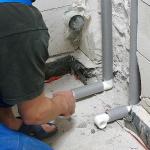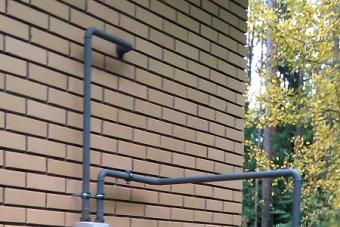Gasification of a private house- the process is quite expensive and laborious. However, if you have decided to supply gas to your home, then you need to know what is required for this - what permits are needed to gasify your home, what work will need to be done, and how much it will cost.
Briefly about the main
First of all, you need to find out who is the owner of the gas pipeline (as a rule, it is GorGaz), a meeting with which will determine the possibility of tapping into its gas pipeline. If you received a positive response from him, then the next instance will be a design organization that will develop and produce a project for connecting your house to this particular gas pipeline.
Already with the finished project, you are sent to the installation company, which will take care of all the problems associated with the installation of the gas pipeline. She is also responsible for the commissioning of this section of the gas pipeline, so she must have the appropriate license to carry out this type of work. It is advisable to carry out all settlement operations with the installation organization only after the site has been handed over to the State Control authorities.
When all of the above instances have been completed, and all stages of work have been completed, you can use gas for your own purposes and at your own discretion.
But let's look in order, where to start gasification at home and what you need for this.
Documentation required for registration of gasification of a private house
Documentation includes all kinds of acts and documents that confirm your right to own a residential building and a land plot, permission to gasify a house, etc. Paperwork can be divided into two stages - the first stage is the paperwork that must be completed before the start of work on laying a gas pipeline to your home and the second stage is the documents that are drawn up in the process of work.
First stage. A set of documents when registering gasification at home
- permission of the heads of the architectural and planning department (APU) for gasification of a private house;
- a copy of the technical passport of the Bureau of Technical Inventory (BTI) for a private house;
- topographic survey of the site with the landing of the most private house and gasified structures on the site at a scale of 1:500 with plotted communications and a gas pipeline, certified by the local gas service;
- written permission from neighbors to connect to the gas pipeline, if it is laid along their sections (however, as a rule, such permission must be obtained from GorGaz, since in most cases it is he who owns the gas pipeline).
Documents issued during the gasification process
- an act of inspection of chimneys by a service (in Ukraine - the Ministry of Emergency Situations, a fire inspector).
Obtaining specifications
To obtain technical conditions for gasification, you are sent to GorGaz.
In GorGaz, you will need to provide a BTI technical passport for housing construction, your passport data and an identification code number, as well as write an appropriate application for obtaining technical specifications for gasification of your home.
Note:This service is paid, and you can wait for a decision from 14 to 30 calendar days.
Design
Having solved all the issues in GorGaz, your path lies in the design organization, of which there are a huge number today. Attention! When applying to a particular design organization or design institute, be sure to check the availability of a license to perform this type of work.
The difference in the cost of services sometimes reaches from 10 to 50 thousand rubles (that is, approximately from $ 280 to $ 1,400). But it would be better if you immediately ask GorGaz what design company they will recommend, then there will be fewer problems.
If you need to visit the house of a design engineer to carry out all the necessary measurements, then please note that this item is stipulated in the contract.
It is with the designer that you coordinate the placement of gas appliances in the house and the brand of the desired heating equipment. When the project is ready, the responsible person (designer) will have to coordinate it with the technical department of GorGaz without fail. This procedure may take from 10 to 14 calendar days.
After completing all the necessary steps described above, you will be able to make calculations and draw up an approximate estimate of all work according to the project documentation. Next, you draw up a contract for technical supervision and provide an act of inspection of chimneys by the VDPO service (in Ukraine, the Ministry of Emergency Situations, a fire inspector).
Agreement with a construction and installation organization
When all the necessary documents have been signed and all matters have been settled with GorGaz and the design organization, you are sent to the installation organization, which will subsequently carry out all the necessary construction and installation work. Do not hesitate to check her license as well, since it is the installation organization that must hand over the work to GorGaz, therefore, an entry in the GorGaz registry should testify to its existence.
Note:in most cases, installation organizations have a license to perform not only installation, but also design work, in this case, if you order the project directly from the installation organization, the cost of gasification at home is reduced by 25-30% of the total amount.
When you have agreed with the installers the terms and cost of the work, be sure to sign a contract with them, so that in which case you have at least some guarantees from the contractor.
The contract will contain guarantees and obligations on the part of the installation organization.
Guarantees in the process of laying the external and internal gas pipeline:
- in the production of construction and installation works, the contractor must have all the necessary fire extinguishing equipment, as well as a protective screen necessary to protect the surface of the walls from heating;
- after the final payments for the work performed, the installation organization transfers to you the executive and technical documentation;
- the construction and installation organization undertakes to timely and efficiently perform all work under this contract.
During commissioning:
- to establish optimal modes of gas equipment to ensure the rational use of gas;
- instruct you in the correct operation of the equipment;
- if it is impossible to debug the operation of gas equipment or individual units, establish the reason for such an impossibility to fix it in the act and suspend work until the identified deficiencies are eliminated;
- hand over the result of the work with the execution of a bilateral act for the work performed.
Drawing up as-built technical documentation
The installation of the gas pipeline is completed, as well as all the necessary equipment, then the executive and technical documentation is drawn up, and the installed gas pipeline is accepted by a special commission consisting of their customer, contractor and representative of GorGaz.
The term for acceptance by the commission can be from 14 to 30 working days. If no comments were made, then the representative of GorGaz will issue you a technical supervision receipt, which you will have to pay and then transfer a copy to the installation organization. On average, the payment is about 1,500 rubles ($43).
Please note that at the time of acceptance, not only must be installed, but also connected all the equipment listed in the project documentation. After the commission is held, the installation organization will prepare and transfer to GorGaz all the necessary technical documentation, where it will be stored.
Based on the decision of the commission and on the provision of all documents to GorGaz, the meter will be sealed within 21 working days and an agreement will be concluded with you for the supply of gas, as well as for further maintenance of both the gas pipeline itself and the gas equipment located inside the house.
Safety briefing
When all of the above list of actions is left behind, you will be required to undergo a safety briefing when using gas.
You can go through the briefing directly in GorGaz, where you will be instructed by the safety engineer, after the briefing, you sign in the magazine, which remains in GorGaz.
You can also be instructed at home by a certified specialist to conduct safety briefings during the commissioning of gas equipment. You, just like after the briefing at Gorgaz, sign in the HSE log, later this log will be transferred to GorGaz.
Connection to the main gas pipeline
In order to tie your gas pipeline into the main gas pipeline, you must first pay for the work that will be carried out by a special tie-in service, with which you will also have to agree on the terms in advance.
After tapping the gas, representatives of the district gas service open the gas cock and carry out a test run of gas to the devices, thus checking for leaks (this service is paid - on average, the cost of such a service can be 3,000 rubles ($ 84)).
Commissioning works
After starting the gas, you will need to contact the organization with which you have signed a service agreement for all provided gas equipment in order to put this equipment into operation. This will be one of the most important conditions for the warranty service of your equipment within the prescribed periods in the warranty service agreement (what warranty period will be set depends on your place of residence, on average, the warranty period for servicing gas equipment is from 1 to 3 years)
You will also need documents to perform a heat engineering calculation, which will help determine the required boiler capacity to provide heating and hot water supply to a private house (for this, you can contact specialists from the housing and communal services):
- floor plans of all heated premises of the house with an explication, as well as an indication of heights and areas;
- types and number of points of hot water intake (such as washstands, baths, showers, etc.);
- description of the possible use of a gas boiler for technological needs.
The owner of a private house has the right to make all the approvals either independently or contact an organization that deals with the issues of gasification of the house and the installation of a gas pipeline.
Types of gas pipelines
Now that you have familiarized yourself with the conditions for gasification of your home, we will consider what types of gas pipelines exist and which one to choose for gasification of your home.
According to their location relative to the surface of the earth, gas pipelines are divided into underground and aboveground, which are distinguished by the method of entering into the building both the internal gas supply networks and risers that serve to distribute gas over the floors of the house, and all gas-consuming devices.
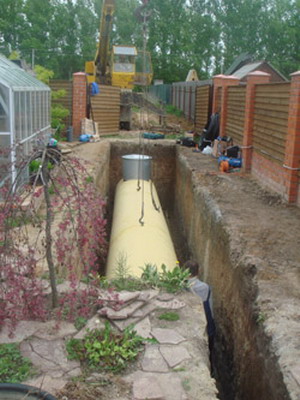
Underground gas pipeline
It is known that construction underground gas pipeline costs much more (about 60%) than overground. But, nevertheless, such a high cost (1 linear meter of laying an underground gas pipeline costs about 1,300 rubles ($36.6)) does not make the underground gas pipeline less popular. This is due to the fact that a pipe running in the ground is much more protected than a pipe running through the air, which means it will last much longer. Moreover, it is less dangerous for the environment.
During the laying of an underground gas pipeline, it is necessary either to completely block traffic, or to restrict travel on certain sections of the road. To do this, the organization performing the installation work, on the basis of its project documentation, draws up schemes for the organization of traffic, both vehicles and pedestrians, as well as the placement of equipment, indicating the geometric parameters of the desired site and entrances to houses, detours and places for arranging road signs.
Schemes for organizing traffic and fencing the places of work on laying an underground gas pipeline are coordinated with the department of the State Traffic Safety Inspectorate (GIBDD), which issues an order for this type of work.
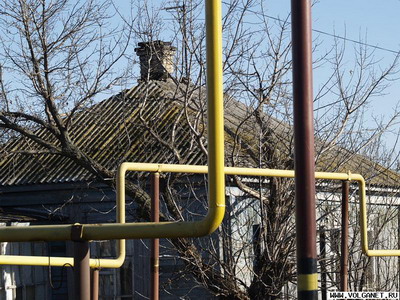
Above ground gas pipeline
Concerning elevated gas pipeline, it has both its advantages and disadvantages. So, for example, open sections of the gas pipeline are more susceptible to corrosion, it is easier to connect to such systems without authorization. Underground gas pipelines are considered more reliable, but their repair is accompanied by additional costs.
Let's compare two types of gas pipelines, in order to make it easier for you to make your choice - which of these types is best for you:
- if in the area where you live, the soil has high rates of corrosion, then in this case it is appropriate to lay the above-ground gas pipeline;
- if a high-voltage power line passes near the place of laying the gas pipeline, then in this case the best option would be to lay an underground gas pipeline;
- if the gas pipeline goes through a neighboring land plot, then in order to avoid damage to the fertile layer of the earth along the entire gas pipeline line leading to your house, it is best to choose the installation of an above-ground type of gas pipeline, in which case it will be easier to obtain permission from neighbors to lay the gas pipeline along its land plot;
- if you have to lay a gas pipeline across the road, then in this case you can choose a combined option: an underground gas pipeline is laid across the road, and an above-ground gas pipeline is laid along the land plot.
Material for gas pipes
Now, knowing what types of gas pipelines are, in this part we will consider the question of what types of pipes are used when laying a gas pipeline.
Some 10-15 years ago, pipes for the gas pipeline were made only of steel. Today, polyethylene pipes are in great demand, which not only are not inferior in their properties to steel pipes, but also have a number of advantages:
- such pipes are highly resistant to the negative effects of various chemical compounds and environmental factors;
- they are strong and at the same time sufficiently plastic, which makes it possible to lay a gas pipeline in areas with particularly harsh climatic conditions.
Note:at low temperatures up to -45 degrees, polyethylene does not lose impact strength.
- since plastic is not a conductor of electric current, such pipes are absolutely insensitive to the effects of stray currents and, therefore, have reliable protection against electrochemical damage. Therefore, plastic pipes do not need additional protection before they are laid in the ground;
- the weight of plastic pipes is 7 times less than steel pipes. Moreover, they are supplied in special compact coils, which greatly simplifies their transportation;
- installation of such pipes is simple and convenient;
- the warranty period of operation of plastic pipes is 2 or even 3 times longer than steel pipes, and is more than 50 years.
Important! the introduction of gas pipeline pipes into the house is carried out only with steel pipes, as well as the distribution of the gas pipeline inside the house.
But gas pipelines made of polyethylene pipes have not only advantages, but also limitations on their use for the installation of gas pipelines, which are stipulated by SNiP 2.04.08-87. Below are some of the restrictions on the construction of a gas pipeline using polyethylene pipes:
- the installation of a gas pipeline made of polyethylene pipes is prohibited in areas where the temperature regime of the outside air reaches below minus 45 degrees;
- it is also forbidden to install gas pipelines using polyethylene pipes in areas where seismicity exceeds 6 points;
- the installation of gas pipelines using polyethylene pipes is prohibited both above and below ground, as well as inside buildings, in tunnels, collectors and channels;
- on land plots where it is planned to arrange crossings through artificial and natural barriers, laying a gas pipeline from polyethylene pipes is also prohibited.
Choosing a heating boiler
Having considered issues related to the conditions of gasification at home, types of gas pipelines, it is necessary to consider another of the equally important issues of gasification - this is the choice of a heating boiler.
As for the choice of a boiler, today the modern market offers a wide variety of heating gas boilers. They are divided into floor and wall.
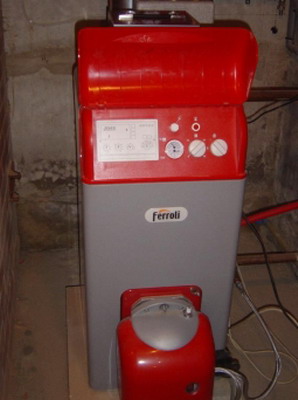
Floor standing gas boiler
A distinctive feature of floor gas boilers is a huge choice of equipment power, which is able to heat more than 150 m2 of space. With the additional installation of a boiler, a gas boiler will provide maximum hot water supply.

Wall mounted gas boiler
Wall-mounted gas boilers are distinguished, first of all, by their compactness, built-in automatic security system, the presence of an expansion tank and circulation pumps, as well as a relatively low cost. They are usually designed to heat a room with a total area of up to 150 m2 and provide up to 2 taps with hot water.
Heat Exchanger Material
As for the material from which heat exchangers are made in boilers, it can be cast iron or steel.
Cast iron heat exchanger characterized by a long service life (the service life of a gas boiler with a cast-iron heat exchanger is 20-25 years, and a boiler with a steel heat exchanger is 10-15 years) due to high corrosion resistance.
As a rule, the heat exchanger is made of cast iron from sections, which makes it possible in the event of an accident not to dismantle the entire boiler, but to isolate only those areas that have been damaged. Keep in mind that a boiler with a cast-iron heat exchanger is highly sensitive to both mechanical and thermal shocks, so cold water must be added only after the heat exchanger has completely cooled down.
Gas boiler with steel heat exchanger compared to a boiler with cast iron heat exchanger has a much lower weight and lower price. A boiler with such a heat exchanger is not afraid of mechanical stress, but is subject to corrosion.
Note:a boiler with a cast-iron heat exchanger weighs from 114 kg, and its cost is from 30,000 rubles ($ 845), and a floor-standing boiler with a steel heat exchanger weighs from 60 kg and costs from 12,000 rubles ($ 340).
Non-volatile and volatile boilers
Non-volatile boilers, characterized by natural circulation, have a number of disadvantages: this is the large diameter of the pipeline itself, and the presence of an open expansion tank, and the installation features of the system with its slope, but the most important thing is the inability to regulate the air temperature in the room. At the same time, the room in which the boiler with an open combustion chamber is supposed to be installed must have both tidal and exhaust ventilation and a chimney.
Concerning volatile boilers, then they have a closed expansion tank, circulation pumps and full electronic automatic boiler control. Thus, they can rightfully be considered a mini-boiler room. However, it is necessary to take into account the fact that the uninterrupted operation of the entire heating system must be ensured by a stable mains voltage of 230 ± 10% in the presence of a voltage stabilizer.
Only a specialist can decide on the choice of a gas boiler, its power, as well as designate a piping scheme and determine the need for additional automation. To calculate the approximate power of a gas boiler, you can make calculations based on the fact that per 10 sq. m of the room requires 1 kW of boiler power + from 15% to 20% of the reserve, designed to pay off unforeseen heat losses.
Note: to calculate heat loss, you can ask a question in the section.
As for the removal of combustion products in gas boilers, this process can occur either naturally or by force (turbo). In boilers with natural draft, gas is removed by draft in the chimney; in boilers with forced draft - with the help of a fan built into the boiler.
Gas boilers with a "turbo" system are in most cases installed at facilities that do not have a traditional chimney. Then, specialists install a coaxial chimney, which is a kind of “pipe in a pipe” leading out to the street through the wall.
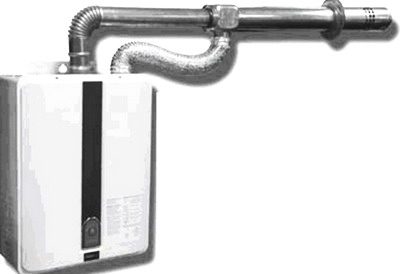
coaxial chimney
The outer pipe is designed to supply air, and the inner one - to remove combustion products. A forced draft gas boiler is also installed in a house where it is undesirable to once again take air from the room.
What you should pay attention to when bringing the coaxial chimney to the street:
- the chimney pipe must be at least 2 m from the ground;
- even during the design of the gas pipeline, if a boiler with a coaxial chimney is installed in your house, you should pay attention to the fact that the output of combustion products from the boiler does not fall back into the open windows back into the house;
- it should also be taken into account that condensate may form in the coaxial chimney;
- the coaxial chimney must have an unimpeded discharge of combustion products to the street, for this it is necessary that the distance from the end of the outer part of the chimney to the buildings located near the house is at least 1.2 - 1.5 m.
Boiler house
As you know, the main condition for the combustion of natural gas is its complete combustion, which occurs only with a sufficient amount of oxygen. Therefore, the parameters of the room must be sufficient for the installation of a gas boiler.
The most suitable place for installing a boiler in a private house can only be, perhaps, a special separate room with a window with a window or transom, a chimney, as well as tidal and exhaust ventilation. For air inflow, a grate or a special gap with a cross section of at least 0.025 m2 should be provided in the lower part of the door. For boilers with a power of up to 30 kW, an ordinary kitchen can also serve as such a room.
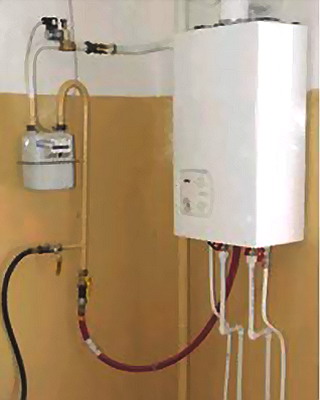
Boiler on the kitchen wall
In the room provided for the gas boiler, there must be a water supply system, a drainage ladder and a gas detector. The latter will help control the micro-concentration of carbon monoxide and give a signal to an individual warning alarm system, which, if the level is exceeded, will cut off the gas supply. An exhaust hood must also be provided in the room.
Extraction power calculation
M = (SxHx12) + 30%, where:
- M - hood power;
- S - kitchen area;
- H - ceiling height in the kitchen;
- 12 - every hour (according to SES standards) the air in the room where the gas boiler is located must be updated up to 12 times;
- 30% is the minimum power reserve required for effective air purification.
Extraction power calculation example
In the room where the gas boiler is installed, the area is 7 m2, the ceiling height is 2.5 m.
The exhaust power required for such a room is:
M \u003d (7x2.5x12) + 30% \u003d 273 m3 / h
Note: it is necessary to take into account the fact that a 30% power reserve is enough only if the hood is located directly above the boiler. In other cases, when calculating the exhaust power, you should add another 15% for each turn of the duct pipe and another 10% for each meter of the duct.
In one room of a private residential building, it is not allowed to install more than two small-sized boilers. The volume of the room intended for heating equipment with a total heat output of up to 30 kW must be at least 7 m3, while the duration of stay of people during the day on the territory of this room should not exceed 4 hours.
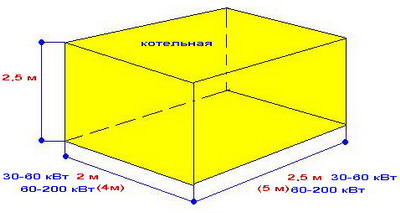
Boiler room dimensions
As for heating gas equipment with a power of 30 to 60 kW, it is necessary to provide for it a separate non-residential premises, built-in or attached to the house, the total volume of which must be at least 7 m3, for boilers with a power of 60 to 200 kW, the volume of such a room must be at least 11.5 m3.
The place provided for the installation of the boiler is specially separated from adjacent rooms by enclosing partitions with a fire resistance limit of 0.75 hours, while the limit of fire spread over the entire area of \u200b\u200bthe structure must be equal to zero. Such partitions are made to the entire height of the boiler, while the height of the room must be at least 2.5 m.
The walls and floor of a separate room for the boiler room must be fire resistant and not be a source of dust. One of the most optimal solutions for creating and maintaining cleanliness in the boiler room will be the cladding of walls and floors with ceramic tiles, as well as oil paint coating. Since it is dust that leads to the deposition of contaminants on the burners and in the channels of the heat exchanger, which greatly reduces the performance of this heating equipment.
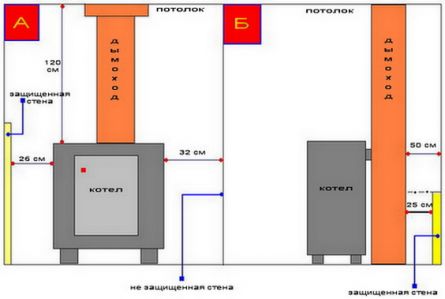
Diagrams of distances from the boiler to other structures in the house
A. The distance from the top of the boiler to the unprotected ceiling must be at least 120 cm. The distance from the outer surface of the boiler or pipe to the wall or partition is at least 32 cm (if the building structure is protected by a metal sheet over asbestos, then the distance can be from 26 cm) .
B. The distance from the inner surface of the pipe to the combustible structure should be less than 50 cm (if it is protected by a metal sheet on asbestos cardboard with a minimum thickness of 8 mm or plaster with a thickness of 25 mm or more on a metal mesh, then this distance should be from 25 cm).
It is also necessary to take into account the parameters of the location of the gas pipeline relative to the house electrical network. For example:
- the distance of the gas pipeline from the electrical panel must be at least 30 cm;
- from electrical wires that are laid in an open way - at least 25 cm;
- from hidden wiring - about 5 cm.
All safety parameters, indicating the location of the heating gas equipment in centimeters, are clearly spelled out in the installation instructions for each individual boiler model.
An important condition for the smooth operation of heating gas equipment are chimneys for boilers with natural ventilation. They are internal, i.e. pass through the ceiling and the roof of the house itself, and external - mounted along the outer surface of the wall.
The choice of the most optimal chimney should be carried out by a specialist. You only need to know that the inner diameter of the chimney must be no less than the diameter of the boiler mouth; there should be a minimum number of various bends and elbows in the way of flue gases; when installing a chimney, it is imperative to take measures to prevent the formation of condensate.
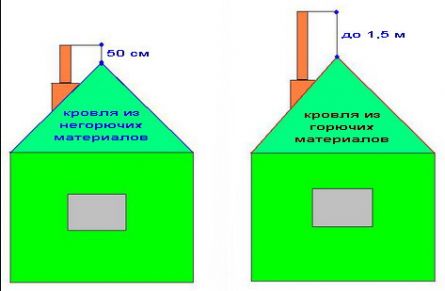
The scheme of raising the chimney above the house
The chimney should be raised 50 cm above the top of the building. If the roof of the house is made of combustible materials, then the chimney should be brought out 1 or even 1.5 m above the roof ridge. The presence of nearby higher buildings also affects the elevation of the chimney.
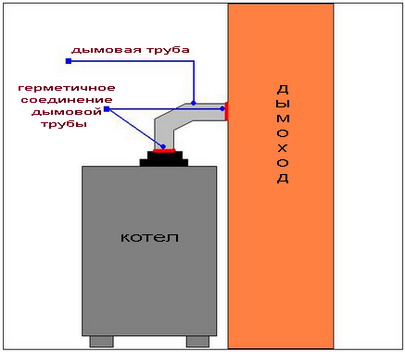
Places for sealing the chimney in the house with heat-resistant sealant
In order to avoid leakage of smoke into the heated room, all junctions of the chimney modules with each other and with the boiler itself are specially sealed with a heat-resistant sealant.
To ensure the smooth operation of modern heating boilers, high-quality chimneys are required that can prevent the occurrence of such problems as the destruction of brickwork, the appearance of greasy spots on the walls and ceiling of the boiler room, the penetration of carbon monoxide into the heated room, etc.
The most optimal option in terms of price / quality ratio are chimneys made of stainless steel. They are single and double layered. The former, as a rule, are used for laying a chimney indoors. However, they have a significant drawback - abundant condensate, which appears in the case of flue gases from modern gas heating facilities with high power.
Two-layer insulated stainless chimneys, as you understand, consist of two layers of steel, between which a heater is placed, which can significantly reduce the amount of condensate that forms.
Please note that when choosing a chimney, it is necessary to take into account the power of the boiler, the temperature of the outlet of the combustion products, the material of the shaft and its insulation, as well as many other points that affect the draft, durability, reliability and safety of the chimney.
Note:if the boiler has a power of up to 60 kW, then it is enough to make a chimney from non-combustible materials, for example, from roofing steel, but if the boiler has a power of 60 kW or more, then it is best to make a brick chimney riser.
As for the cost, the design work on gasification of the house, which is carried out by special design institutes, will cost you about 5 thousand rubles (about $ 140). Today, 1 meter of the pipeline costs - from 800 and from 1300 rubles (that is, approximately from $ 22.55 and from $ 36.6 - of the above-ground and underground gas pipelines, respectively).
It is difficult to name the exact cost of installation work, since it depends on many indicators: the number of holes in the walls of a private house, the diameter of the gas pipeline itself, the number of bends, etc.
Thus, for the implementation of gasification of a private house, it is necessary to count on the amount from 110 to 145 thousand rubles, i.e. approximately $ 3000-4000 (the indicated amount includes the cost of the boiler itself, as well as all construction and installation work, house wiring and installation of an individual gas control system).
And so, now we know what the process of gasification of a private house includes:
- development of project documentation;
- input of the gas supply system to the house from the street gas pipeline;
- wiring of gas networks inside the house itself;
- cost and installation of gas equipment.
Heating with a gas boiler implies the ability to independently set and regulate the temperature in the room, which means it allows you to feel comfortable and cozy in it.
APPENDIX
Having studied the article on gasification of a private house, it will be easier for you to supply gas to your house, since you have the necessary information and know in advance what you need to do.
But let's go back to the section "Gasification - step by step" (Documentation) and look at some documents with tips that will help you in the speedy execution of these documents:
- an act of inspection of chimneys by a service (in Ukraine, the Ministry of Emergency Situations, a fire inspector) of the All-Russian Voluntary Fire Society (VDPO);
Advice: before inviting a specialist of VDPO or the Ministry of Emergency Situations, you should prepare the room - equip it with an exhaust hood (if it is not already there), the room must be isolated from other rooms located in the house - pay attention to the fact that the entrance to the room must be closed, and the door had no glass.
Also, if your chimney is made of brick (riser), then it is necessary that its internal section be not less than the diameter of the gas boiler chimney outlet. The riser should have a blower with a tightly closing door (through the blower, the inspector will check the internal condition of the chimney and its size with a mirror).
- written permission from neighbors to connect to the gas pipeline, if it is laid along their sections (however, as a rule, such permission must be obtained from GorGaz, since in most cases it is he who owns the gas pipeline);
Advice: if the gas pipeline to your house from the main gas pipeline will have to be laid through a neighboring site, then you need to discuss this with its owner, even before submitting an application for gasification of your home, since in some cases the solution to this issue may not be received so quickly. And without the permission of the owner of the site through which the gas pipeline will go to your house, the GorGaz service cannot begin work on its installation. If the issue is resolved and the neighbor has agreed, then be sure to confirm it in writing (arbitrary) addressed to the manager of GorGaz and attach a copy of it to the application.
Basically, the issue of laying a gas pipeline through a neighboring section is resolved privately by agreement of the parties (for example: a one-time cash payment to the owner of the site for laying the gas pipeline through its territory).
- documents for gas equipment that will be installed in the house (certificate of conformity, permission to use this equipment on the territory of your place of residence, contract for further maintenance of this equipment);
Advice: when buying a gas meter, you should pay attention to the following points - if you buy a meter on your own, then its brand must strictly correspond to the one that will be indicated in the project documentation. A technical passport is attached to the meter - you should check that the serial number indicated in the passport matches the number on the meter. Since if the numbers do not match (this happens), you will have difficulty registering it in GorGaz and commissioning will be postponed until you eliminate the inaccuracy in the documentation for the meter.
Attention! The prices given in this article were current at the time of 2009.



